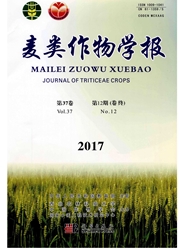

 中文摘要:
中文摘要:
为给小麦变量施肥提供依据,利用冬小麦起身期扣拨节期冠层光谱数据,选用反映冬小麦长势信息的优化土壤调节植被指数(OSAVI)和变量施肥模型进行变量施肥管理,以相邻地块常规非变量(均一)施肥区为时照区,研究了基于光谱指数的变量施肥时冬小麦产量构成的影响厦其效益。结果表明,变量区OSAVI的变异系数较时照区有所降低;变量区产量、穗数和穗重高于时照,且变异系数均较对照区有所降低;变量区的穗粒重低于时照区,但变异系数增加;变量区的千粒重高于对照区,变异系数相近。变量区籽粒蛋白质含量高于对照,变异系数低于时照。变量区农作物经济效益高于对照区。土壤硝态氮浓度降低,生态效益明显。
 英文摘要:
英文摘要:
This study was to develop the time-specific and time critical method to overcome the limitations of traditional field sampling methods for variable rate fertilization. Farmers, agricultural managers and grain processing enterprises are interested in measuring and assessing soil and crop status in order to apply adequate fertilizer quantities to satisfy crop growth. This paper focused on studying the relationship between vegetation index (OSAVI) and nitrogen content to determine the amount of nitrogen fertilizer recommended for variable rate management in precision agriculture . The uniform rate fertilizer management was chosen as the CK. The OSAVI, grain yield, ear numbers, 1000-grain weight, and grain protein content were measured among the CK and variable rate fertilizer treatments. It indicated that variable rate fertilization reduced the variability of wheat yield, ear numbers, OSAVI and grain protein content ,but it did not increased grain protein content significantly and did not decrease the 1000-grain weight, compared to the uniform rate application. Economical and environmental benefits of fertilization in variable rate application were better than those in uniform zone. So the variable rate technology based on vegetation index could be used to prevent under ground water pollution and environmental deterioration.
 同期刊论文项目
同期刊论文项目
 同项目期刊论文
同项目期刊论文
 期刊信息
期刊信息
